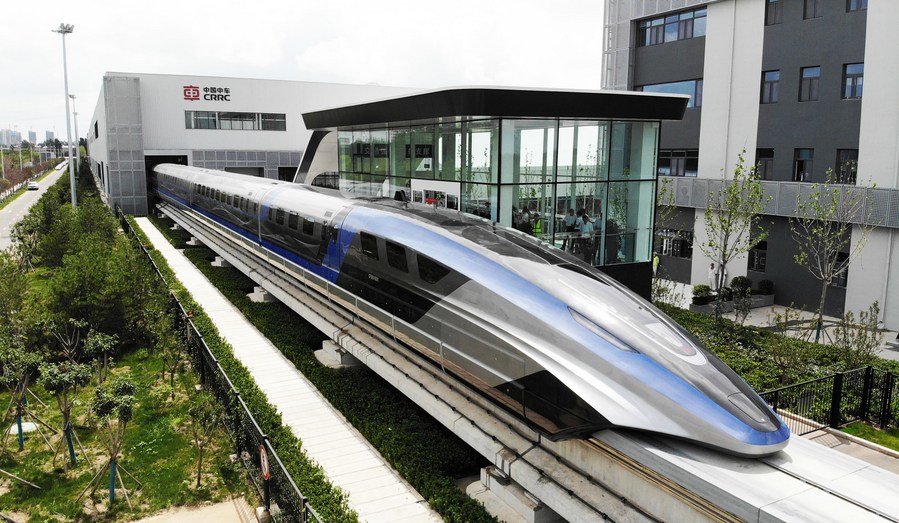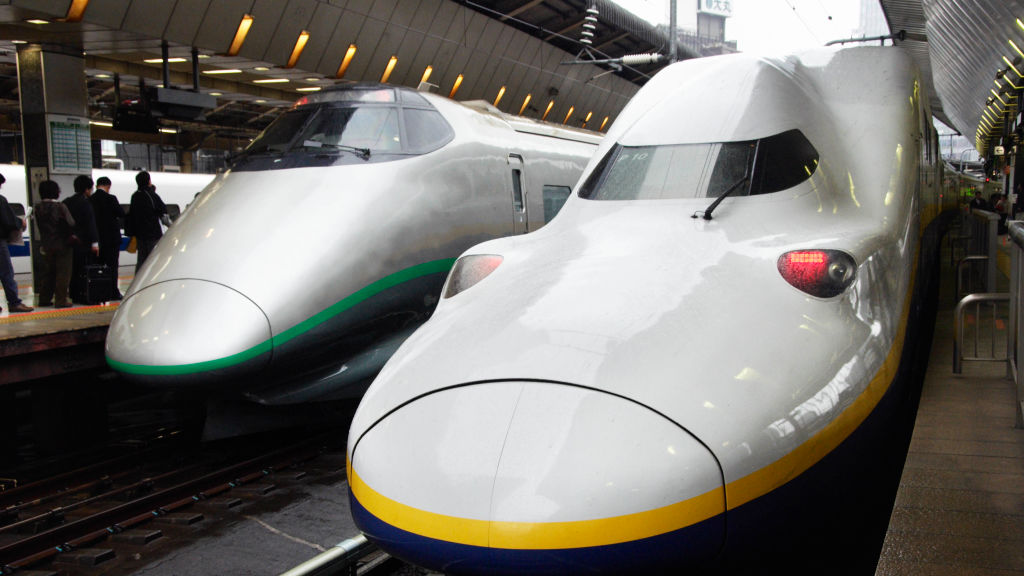
China's new maglev transportation system is shown in Qingdao, east China's Shandong Province, July 20, 2021. /Xinhua
China's new maglev transportation system is shown in Qingdao, east China's Shandong Province, July 20, 2021. /Xinhua
Editor's note: Djoomart Otorbaev is the former Prime Minister of the Kyrgyz Republic, a distinguished professor of the Belt and Road School of Beijing Normal University, and a member of Nizami Ganjavi International Center. The article reflects the author's views and not necessarily those of CGTN.
On July 19, China's first high-speed magnetic suspension train with a top 600 kilometers per hour speed rolled off the Qingdao, Shandong province. It was developed entirely by CRRC Qingdao Sifang, a state-owned China Railway Rolling Stock Corp subsidiary. To launch trains of this type into operation, they must pass many years of testing. In addition, it will be necessary to build entirely new high-speed tracks using magnetic suspension technology.
Those involved with the project are optimistic it will completely transform China's travel landscape, filling the gap between high-speed rail and air transportation. "Take Beijing to Shanghai as an example - counting preparation time for the journey, it takes about 4.5 hours by plane, about 5.5 hours by high-speed rail, and [would only take] about 3.5 hours with [the new] high-speed Maglev," said CRRC deputy chief engineer Ding Sansan, head of the train's research and development team, in a statement.
Maglev technology was first described by Jonathan Swift back in 1726 when in Gulliver's Travels, he described Laputa Island as land capable of floating several kilometers in the air using magnets to levitate.
Maglev (from magnetic levitation) is a system of train transportation that uses two sets of magnets: one set to repel and push the train up off the track, and another set to move the elevated train ahead, taking advantage of the lack of friction. The train travels along a guideway of magnets with Maglev technology, which controls the train's stability and speed.
Magnetic levitation technology, first developed in the 1940s by British engineer Eric Laithwaite, is still not widely used in transportation. Shanghai Maglev Train is the fastest commercial passenger train globally, reaching 430 km/h in operation today. The only other Maglev systems currently serving the public are Linimo in South Korea. In 2015, an experimental Maglev train in Japan broke the record for the fastest train globally, traveling at 603 km per hour.
It is worth emphasizing that few are as controversial as Maglev among the latest technologies. The very fact that after being developed eighty years ago, magnetic levitation technology has so far failed to reach the transportation mainstream says a lot. Therefore, it is essential to determine whether the application of this technology in transportation will have a future.

Shinkansen or Bullet Trains at Tokyo Station, Japan. /Getty
Shinkansen or Bullet Trains at Tokyo Station, Japan. /Getty
The benefits of a Maglev are hard to dispute. By replacing wheels and supporting mechanisms with electro- or superconducting magnets, hovering trains can reach high speeds. Preventing interactions between wheels and rails also means less noise, no vibration, and no mechanical damage. It is highly efficient in maintenance and has much less trouble in bad weather. It uses 30 percent less energy than conventional trains. Maglev train at a speed of 420 km/h uses half the primary thermal energy per passenger-kilometer than a car at 100 km/h, and only a quarter of what is used by airplanes. Those trains use only electricity, which can come from renewable energy sources. Which reduces pollution and carbon emissions, enables greater and safer mobility at lower costs, and reduces dependence on hydrocarbons.
The main problem facing the development of Maglev technology has always been high costs. It requires an exceptional and dedicated infrastructure, including substations and power supplies. Unlike traditional high-speed trains, new technologies do not integrate into existing transport systems. The Maglev can operate only on its unique tracks, unable to switch to thousands of miles of conventional paths.
"There was already a rail network between the two cities," says Roger Goodall, a professor at Loughborough University. "When they started to analyze it, they realized that it was much cheaper to upgrade this line than to build an entirely new line with completely new technology. This is the problem with the Maglev."
"There are three criteria you need to fulfill," says Goodall, "The first is a large megacity at both ends; the second is a distance of about 500 miles because if the cities are too close, it's not worth going fast, and if they are too far air travel comes into its own; and the third is having no existing railway. There are a very limited number of cases where all these criteria obtain."
Maglev Trains also lacks clear support in the transportation and investment community. With this fact, Lawrence Blow, founder of the Maglev Transport consulting group, has consistently struggled in his thirty-plus years as an advocate in the U.S. "Maglev is a competitor to cars, trains, and planes, as well as buses and subway systems," says Blow. "It has many natural enemies but no natural friends. It was a product of the scientific community, and, by and large, scientists do not dominate transport." For his part, Blow remains convinced that the most significant benefit of using magnetic suspension is "connecting cities," but doubts that this technology will gain widespread acceptance any time soon. "In the current environment, it is doubtful that it will ever enter the mainstream of transportation technology," he says, adding that the Maglev will have to "fight for whatever it gets."
Entirely relying on such a purely capitalist calculation, it seems problematic to develop the new Maglev technology. What will win at the end - the brilliant prospects of new technology or short-term cold mathematics?
(If you want to contribute and have specific expertise, please contact us at opinions@cgtn.com.)

